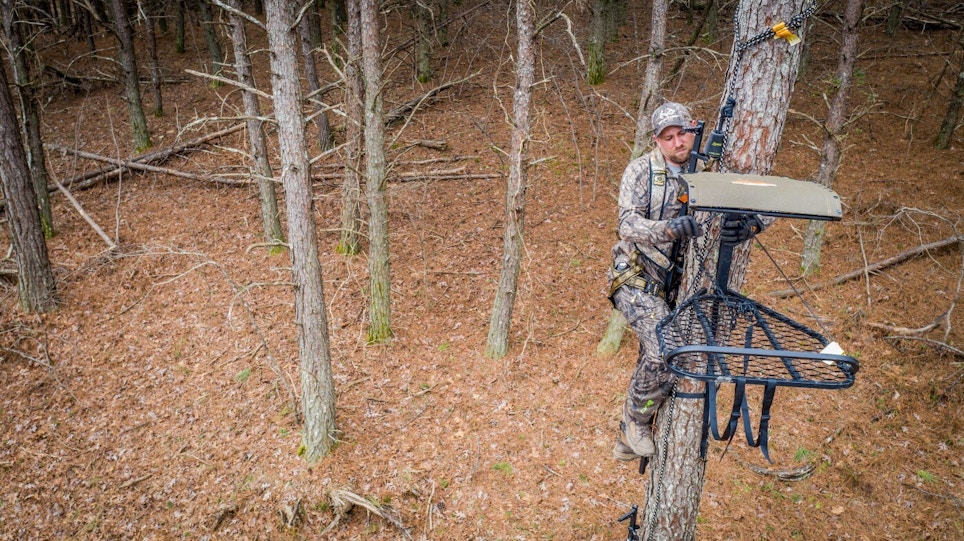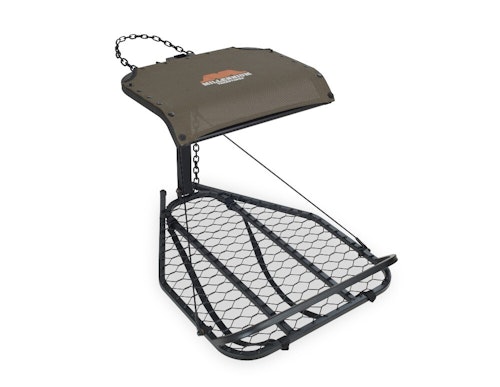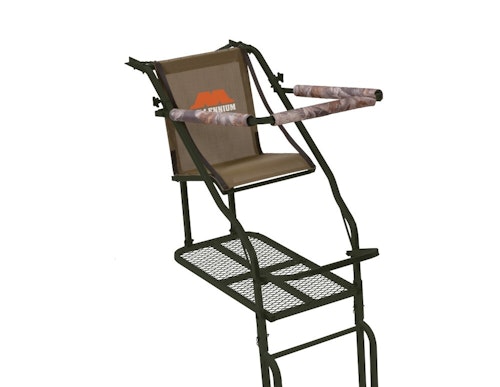Treestands comes in many shapes and styles starting at basic, metal-seat 16-foot ladder stands and go all the way up to five-star resort-like portable housing. While all types accomplish the same task, choosing between the two ultimately comes down to two criteria: use case and price point. To better understand why the $ treestand is more desirable to some hunters than the $$$$ treestand, sellers should understand how the buyer intends to use/hunt out of their purchase to help determine if buying one portable climbing treestand or five basic ladder stands will better serve their needs.
Portable Options: Types
Portable options can be broken down into three main categories: climbing treestands, a combination of ladder sticks and a hang-on stand, and a more recent revival, tree saddles.
Climbing treestands come in many shapes and sizes, but the basic principle of their use remains the same. The vast majority of climbing treestands consist of two different components: a platform and a climbing aid that includes a seat. This type of treestand is considered the most portable, allowing hunters to simply put it on their back and trek into the woods with no specific location in mind. This type of treestand has its own risks/safety concerns, but modern climbing stands aren’t anything like the old, somewhat haphazard versions of the ’90s and, when deployed correctly, mitigate most safety risks.
The second type of portable treestand consists of ladder sticks, or screw-in steps when allowable/legal, and a hang-on treestand. While many may consider these treestands fixed-position, the use of a treestand like Millennium’s M100U Ultralite allows hunters to use on hang-on treestands in multiple locations. The M100U includes a quick-disconnect strap that includes a receiver that the treestand slides into. So, with the purchase of multiple receiver straps, hunters can place ladders sticks in multiple location and use one hang-on stand in every location. Instead of having to carry a bulky climber, they simply carry a lightweight hang-on into the woods.
Tree saddles, while not a new idea, have recently become popular. They consist of a saddle, tether and lineman belt, and a platform. This style of “treestand” is lightweight, very mobile, and adaptable to different tree types. If hunters have ever struggled finding the perfect straight tree for a climber or hang-on stand, tree saddles allow hunters to better adapt to available trees allowing the stand to be put in the right spot, rather than just the closest tree that will work.
Portable Options: Use Cases
Portable treestands are perfect for hunters who hunt multiple locations and don’t want to have the expense of owning 10-20 different ladder/permanent stands spread across two or three different farms. Additionally, even for those who have multiple permanent stands, having a portable option, especially a climber or saddle setup, allows them to adapt to changing deer patterns and movement quickly and efficiently, without creating a significant disturbance just to try out a new area.
Portable Stands: Pros and Cons
Portable stands are a great option for hunters who desire mobility. When the deer vanish due to changes in food sources or pressure, hunters often need to adapt. Being mobile allows hunters to hunt different, new locations at will to try to relocate the buck they are after. The downfalls are they are less stealthy when trying to slip in close to a bedding or feeding area, as the setup required at the tree can be noisy. They can also be bulky, and for hunts that require long walks, it is easy to put on a sweat during the walk-in. In order of stealth and ease of use, portable hang-on stands rank first, tree saddles rank second, and climbing stands rank third, as they are the most cumbersome.
Of the three options, climbing stands and tree saddles are the most affordable, as hunters only need one setup for the entire season. Ladder sticks and a portable hang-on are a more expensive combination, but they allow hunters to purchase one hang-on stand and have multiple sets of ladder sticks to cover more area in different locations with ease. Additionally, compact sets of ladder sticks can be purchased, allowing the hunter to carry ladder sticks and a hang-on into new locations with ease.
Fixed-Location Stands: Types
Fixed-location stands can also be broken down into categories, but for different reasons. These categories include budget, comfort and deluxe. While all three serve the same purpose, the driving differences between them are price point, which may define the number of stands a hunter can afford, and comfort. They can also be purchased in one- or two-man variants and are perfect for mentoring a youth or new hunter.
Budget ladder stands are generally just bare-bones versions of higher-end treestands. A general description would be a simple metal ladder attached to a small platform with a rigid, metal seat equipped with a thin foam pad. For hunters who want to cover a lot of ground and slip in and out of a spot with minimal disruption, they are easy to get in and out with nothing to setup, attach, or otherwise make noise when the hunter climbs into them. They are also cheap, so owning several of this style of treestand is not out of the question.
Comfort-level treestands are a step up from budget ladder stands. These stands expand upon the ease of use associated with budget ladder stands but include many features that make long sits much more tolerable. Upgraded features include over-sized sling/padded seats, a footrest, expanded platform, gun rail, and sometimes even an enclosure to keep hunters out of the weather. These stands are generally two the three times the price of the more basic budget options, so if a hunter has a budget to set up a new deer lease, they could get half to one-third as many comfort treestands as they could budget versions. Understanding the intention of the purchase will go a long way to balancing features against a volume purchase.
Deluxe treestands are probably better known as shooting houses. A stand like Millenium’s Buck Hut tower stand combines an elevated platform with a complete enclosure or blind, for maximum concealment and comfort. These stands are best used in known hunting locations, as they are not portable, and best built on-site during installation. While they can be moved, it isn’t without a lot of effort and the help of a few friends. They generally have multiple windows/shooting ports and plenty of room to spread out gear, and they can even be used with a portable heater to help stave off the cold.
Fixed-Location Stands: Use Cases
All three of these categories of fixed-position treestands serve the same purpose; however, their increasing levels of comfort offer benefits for all-day sits, like during the rut or on opening day of rifle season. In instances where a hunter plans to hunt in a legacy or well-known travel corridor for many seasons, placing a comfort or deluxe style of treestand/shooting house in the location will help reduce fatigue and, in the case of a shooting house, can even help keep the hunter out of the elements. When hunting with youth, deluxe stands can be the difference between hunting a few hours in the morning and hanging out all day waiting for mid-day action.
Fixed-Location Stands: Pros and Cons
Fixed-location stands are easy to use once hung. They allow hunters to stealthily enter and exit their hunting area, and they are safe to use. When equipped with a shooting rail, these stands offer an added level of safety and a steady platform for taking shots with a rifle or crossbow. They also provide an increasing level of comfort as you increase price point and have many features that aren’t found on portable options, like enclosures and seating for two people.
The downside to these stands is that they are cumbersome to move through the woods, require multiple people to set up, and are difficult to hide. Additionally, when equipped with a shooting rail, use with a conventional vertical bow is difficult if not impossible. As the name implies, they are also used in a fixed location, so if a hunter intends to hunt multiple locations, they must buy more than one stand to cover the entire hunting area, increasing costs.
Add-On Accessories
In addition to selling treestands, sellers shouldn’t overlook the need for accessories. These accessories include items like bow ropes, safety harnesses/lines, blinds/enclosures, tree umbrellas, and typical bow hangers, etc. Treestands, and the comfort they offer, are only as good as the accessories that accompany them. Outfitting your buyer with not only the treestand they need but also the accessories that make it functional is a good way to increase your bottom line and ensure a satisfied customer.
To find the treestand that best suits your customer and make the sale, make sure you understand their needs and how they like to hunt. Knowing these factors will allow you to guide them into the right style of treestand right off the bat, and then allow price point and features to help narrow down their selection. If a hunter wants to hunt multiple locations but has a budget of a few hundred dollars, a climbing stand or tree saddle may be the most appropriate choice. If a hunter values safety and ease of use at the forefront, fixed-position stands are best, and the level of treestand purchased will be commensurate with the number of stands that they need and budget they have to spend on them.








